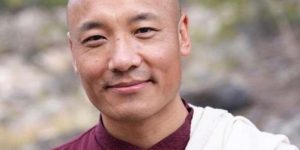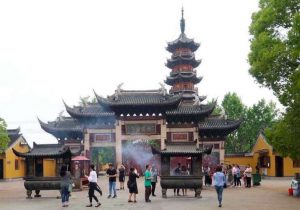
January 2024 marked the second anniversary of Venerable Thich Nhat Hanh’s passage into being an ancestor. I’ve been thinking a lot about him this past month. This gentle yet fierce monk from Vietnam was my gateway into Buddhist practice in the early 1990s, and although it’s been a long time since I’ve studied in his tradition, I continue to feel how deeply Thây’s teachings live in every cell of my body.
It’s impossible to overstate Thich Nhat Hanh’s impact. Thousands of us who had a chance to hear his teachings in person and to practice with him felt our lives change in subtle but powerful ways. On the collective level, he infused our world with the possibility that peace could actually be lived, not just talked about, and that the practice of mindfulness was a medicine that could be applied to some of the deepest wounds of our times: militarism, poverty, addiction, climate change, and more.
There were certainly other great Dharma teachers before and during Thây’s time, but he had a unique way of directly addressing the daily needs and challenges of so many of us: veterans of war, school teachers, healthcare workers, activists, and artists, to name a few. We have Thây to thank for the vitality of socially engaged Buddhism in our world today. Following are just some aspects of his legacy:
Healing the wounds of war
For many years, Thich Nhat Hanh and the sangha made it a practice to offer retreats to Vietnam veterans and their families on a regular basis. He once said, “The Vietnam war was not 15 years ago. It is today. If we look deeply at the present, we will see that it is made up of the past. And if we contact the present deeply, we can contact the past and heal it.”
Education
Plum Village has long been a place where children and families are warmly welcomed, and over the years many teachers would also show up for retreats. As Thây listened to their experiences and challenges in their schools, he offered ways for them to bring mindfulness practice into educational settings. Along with the monks and nuns, he held retreats for educators around the world and called for a secular movement known as “applied ethics” which later became the Wake Up Schools project.
Climate activism
The Earth Holder Community is a branch of Plum Village that applies Thây’s teachings on engaged Buddhism, mindful living, social and racial justice, and interbeing with Mother Earth at this time of ecological crisis. The community holds annual retreats to nourish the work of climate activists, and has developed numerous resources, such as the Compassionate Eating Mindfulness Training and how to move toward a more plant-centered diet.
My own path intersected with Thich Nhat Hanh when I moved to San Francisco in 1993 for graduate school. One of the first things I did when I landed in the Bay Area that fall was attend a five-day retreat in Santa Cruz with Thây and the nuns and monks of Plum Village. The invitation to slow down, to be in the present moment, and to notice the beauty and interconnection of that moment was unlike anything I’d ever experienced before. Honestly, it was a bit terrifying. All the silence and bows and smiling evoked a great deal of discomfort in me, something that’s hard to fathom all these years later when meditation feels like such a natural practice. But at that first retreat I was just about ready to crawl out of my skin. About midway through the retreat, I called my girlfriend at the time and asked her to come pick me up. Fortunately, she talked me out of leaving and I stayed through my discomfort. By the time the retreat ended, this practice of mindful awareness felt right at home. I was hooked, and continued on the path.
I went on to do more retreats with Thây in California as well as traveling to Plum Village in France in 1996, and I studied his teachings with Roshi Joan Halifax who was then his student. For a time, I worked at the Community of Mindful Living and Parallax Press, with co-founders Arnie Kotler and Therese Fitzgerald, and edited The Mindfulness Bell, which published many of his talks as well as articles by other sangha members. By the time I was part of his sangha, Thây was drawing thousands of people to his retreats so I didn’t have the chance for one-to-one time with him. But on one sweet occasion, as the editor of The Mindfulness Bell I was invited to a meeting with Thây and a small group of journalists at Plum Village. I will always treasure that intimate time of sharing tea and simply breathing together with him.
Thây had a way of taking teachings that could seem esoteric and making them accessible in the most poetic way. He was a true innovator, an artist even. As time goes on and my understanding of the Dharma has deepened, I have an even greater appreciation of just how creative Thây was in the way he transmitted the teachings of the Buddha. Take this excerpt from the book Peace Is Every Step that so beautifully conveys the complex Buddhist concept of dependent co-arising:
If you are a poet, you will see clearly that there is a cloud floating in this sheet of paper. Without a cloud, there will be no rain; without rain, the trees cannot grow: and without trees, we cannot make paper. The cloud is essential for the paper to exist. If the cloud is not here, the sheet of paper cannot be here either. So we can say that the cloud and the paper inter-are.
“Interbeing” is a word that is not in the dictionary yet, but if we combine the prefix “inter” with the verb “to be”, we have a new verb, inter-be. Without a cloud, we cannot have paper, so we can say that the cloud and the sheet of paper inter-are.
(Thich Nhat Hanh: Essential Writings, 55)
But his gift went far beyond the words that he spoke and wrote. To be in Thây’s physical presence was the true gift. If you ever had a chance to do walking meditation with him, you know what I mean. Every step became a message of love to the Earth, and to ourselves. When Thây said “peace is every step,” he meant it quite literally.
In honor of this great teacher, here are a couple of my favorite quotes from Thich Nhat Hanh. Let us celebrate that such a bodhisattva, a mahasattva, walked on this Earth during our time and gave so generously of his wisdom and experience.
On engaged Buddhism
When I was in Vietnam, so many of our villages were being bombed. Along with my monastic brothers and sisters, I had to decide what to do. Should we continue to practice in our monasteries, or should we leave the meditation halls in order to help the people who were suffering under the bombs? After careful reflection, we decided to do both—to go out and help people and to do so in mindfulness. We called it Engaged Buddhism. Mindfulness must be engaged. Once there is seeing, there must be acting… We must be aware of the real problems of the world. Then, with mindfulness, we will know what to do and what not to do to be of help.
(Prebish, 268)
On death and dying
This body of mine will disintegrate, but my actions will continue me. . . . If you think I am only this body, then you have not truly seen me. When you look at my friends, you see my continuation. When you see someone walking with mindfulness and compassion, you know he is my continuation. I don’t see why we have to say ‘I will die,’ because I can already see myself in you, in other people, and in future generations.
Even when the cloud is not there, it continues as snow or rain. It is impossible for the cloud to die. It can become rain or ice, but it cannot become nothing. The cloud does not need to have a soul in order to continue. There’s no beginning and no end. I will never die. There will be a dissolution of this body, but that does not mean my death. I will continue, always.
(Thich Nhat Hanh)
If you have your own personal memories of Thich Nhat Hanh, please leave them in the comments below. It would be wonderful to hear your stories.
References
Ellsberg, Robert, ed. 2001. Thich Nhat Hanh: Essential Writings. New York: Orbis Books.
Prebish, Charles S., and Kenneth K. Tanaka. 1998. The Faces of Buddhism in America. Los Angeles: University of California Press.
Thich Nhat Hanh. 2016. At Home in the World. Berkeley, CA: Parallax Press.
See more
In Remembrance: My Interview With Beloved Zen Master Thich Nhat Hanh (Thrive Global)
Wake Up Schools
Healing the Wounds of War (Mindfulness Bell)
Earth Holder Community
Related features from BDG
Buddhistdoor View: Discourse and Praxis – The Interconnected Legacy of Thich Nhat Hanh
Sulak Sivaraksa: Thich Nhat Hanh – My Friend and My Teacher
The Cloud Is Not Lost – In Honor of Thích Nhất Hạnh
Buddhistdoor View: Thich Nhat Hanh’s Peerless Influence
Thich Nhat Hanh’s theology of compassion














